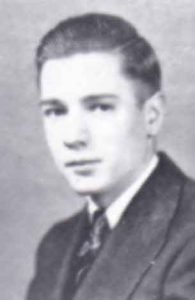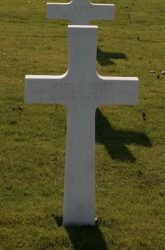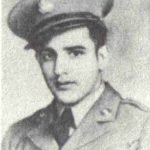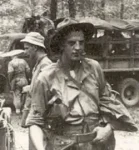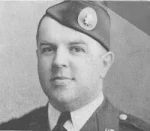S/Sgt. James B. Soule was born in Cook County, Illinois, on October 10, 1925, to Orlando H. Soule and Hariet Alice Burras-Soule and had a sister. His a parents divorced during the 1930s and his father moved to Schoolcraft, Michigan. His mother, sister, and he moved in with his maternal grandparents, and he graduated from Field-Stevenson School and later Proviso Township High School in 1943. During this time, his family resided at 833 South Harlem Avenue, Forest Park, Illinois.
Just before he graduated high school, he enlisted in the Army, on May 5, 1943, and was issued the serial number 16 106 982. On his Army Classification Test he did well and it was determined that he should be assigned to the Army Air Corps. It is not known where he did his basic training, but it is known that he trained at Miami Beach, Florida, from November 25, 1943 to February 13, 1944, at Sioux Falls South Dakota, from February 16, 1944 to August 8, 1944, and Yuma Army Airfield from August 8, 1944 to October 10, 1944. He then did replacement training in Miami, Florida. During this time he qualified as a radio operator and gunner.
James was sent to England as a replacement and assigned to the 703rd Bomb Squadron, 445th Bombardment Group (Heavy), 8th Air Force. The squadron, flew B24s, was stationed at the Royal Air Force Station, Tibenham, England, and its commanding officer was Major Jimmy Stewart. Before each mission, Stewart would read a line from a letter his father had stealthily placed in his pocket when they embraced to say goodbye as Stewart left for England. It was from Psalm 91.
“The thing that takes the place of fear and worry is the promise in these words. I am staking my faith in these words. I feel sure that God will lead you through this mad experience. God bless you and keep you. I love you more than I can tell you. Dad.”
James flew his first mission on April 1, 1945, and another mission on April 3, 1945. On April 4, 1945, his squadron was sent to bomb the German Airfield at Perleburg, Germany. It was during the mission that his bomber was attacked by German fighters. According to records his plane went down west of Perleberg. F/O William H. Williams and James were the only members of the crew who did not get out of the plane. Sgt. Walter Kilman was killed when his parachute failed to open. The other members of the crew were captured and taken prisoners.
Wilhelm Grosche, the Buergermeiser of Bosel, Germany said in a statement.
“On the 4th of April 1945 at the time of the air raid-warning I was near the village and wanted to go home on account of the air-combat. Just as I entered the village, I suddenly saw and airplane came out of the clouds, which plunged almost perpendicular to the ground. During the plunge parts of the airplane fell off.
At the place of the crash, at first a large pall of smoke and then fire could be seen. I wanted to go near the place of crash, but I did not dare go, since ammunition was still exploding. Therefore, I went home. About three hours later I returned and saw a body about 50 meters away for the wreckage. There was a leg and one side missing, the back was torn open and the intestines dould be seen. The top of the skull was missing from the head and the face was indiscernible. The next day I heard that another body had been found.
I had nothing to do with the burial, since at the time I was Buergermeister.”
Another German civilian, Gerhard Mechow, said, “I was at home the day the American airplane crashed on April, 4th, 1945. From the house I noticed the airplane plunge to the ground and thought it would fall into our house.. As the airplane hit the ground, it immediately started to burn. I did not right away go to the place of the crash to close the holes in the ground, which were still on fire. While digging I hit a hand with a shovel and thought something must be lying there. Carefully, I kept on digging and found another body, which is very much torn up. The next day we took the bodies to the cemetery and buried them.”
A third German civilian, Fritz Ludemann, said, “I have nothing to say about the crash of the American airplane, since I was not here at the time. On the day after the crash, I received orders to dig a grave. After I had it finished, the American flyers were brought to the cemetery from 5 boys accompanied by the Burgermeister. The bodies had been wrapped in blankets or coats, and this way were buried. The bodies themselves I did not see. During the summer the grave has been taken care of and on memorial day I put a cross on the grave, adorned it with stones and put them mound in order.”
His mother, who had remarried, received a telegram from the War Department.
MRS ALICE VEITCH
1024 NORTH BOULEVARD
OAK PARK ILLINOIS
THE SECRETARY OF WAR DESIRES ME TO EXPRESS HIS DEEP REGRET THAT YOUR SON STAFF SERGEANT JAMES E. SOULE HAS BEEN REPORTED MISSING IN ACTION SINCE FOUR APRIL OVER GERMANY PERIOD IF FURTHER DETAILS OR OTHER INFORMATION ARE RECEIVED YOU WILL BE PROMPTLY NOTIED PERIOD
ULIO
THE ADJUTANT GENERAL
A letter followed the telegram.
Mrs. Alice Veitch
1024 North Boulevard
Oak Park, Illinois
Dear Mrs. Veitch:
This letter is to confirm my recent telegram in which you were regretfully informed that your son, Staff Sergeant James B Soule, 16 106 982, Air Corps, has been reported missing in action since 4 April 1945 over Germany.
I know that added distress is caused by failure to receive some information or details. Therefore, I wish to assure you that at any time additional information is received it will be transmitted to you without delay, and, if in the meantime no additional information is received, I will again communicate with you at the expiration of three months. Also, it is the policy of the Commanding General of the Army Air Forces upon receipt of the “Missing Air Crews Report” to convey to you any details that might be contained in that report.
The term “missing in action” is used only to indicate that the whereabouts or status of an individual is not immediately known. It is not intended to convey the impression that the case in closed. I wish to emphasize that every effort is exerted continuously to clear up the status of our personnel. Under war conditions this is a difficult task as you must readily realize. Experience has shown that many persons reported missing in action are subsequently reported prisoners of war, but as this information is furnished by countries with which we are at war, the War Department is helpless to expedite such reports. However, in order to relieve financial worry, Congress has enacted legislation which contains in force pay, allowances and allotments to dependents of the personnel being carried in a missing status.
Permit me to extend to you my heartfelt sympathy during this period of uncertainty.
Sincerely yours,
(signed)
J. A. ULIO
Major General
The Adjutant General.
It should be mentioned that Maj. Jimmy Stewart was known for writing each family of every crew member that he lost. James’ mother most likely received a letter from him. Robert was officially declared dead on February 12, 1946, and his mother received an official letter stating he was dead.
After the war, an American Graves Recovery Team arrived at the cemetery in Bosel, Germany, to recover the dead. James’ body was exhumed from the grave and it was noted his head had been crushed. His dental records were used to confirm his identification. From Bosel, the remains of the men were taken the US Military Cemetery Neuville en Condroz, Belgium, where they were buried in a common grave.
Over the next several years his mother was told that his remains could not be identified and later she was informed that James had been identified. At some point, her husband, Guy Veitch, asked that the Office of Quartermaster General stop sending letters since they upset his wife who was ill. He also stated that his wife wanted James buried in a US Military Cemetery overseas. She was sent a form and asked to fill it out and return it to the OQMG in Washington DC. It was returned on January 6, 1950, and indicated James should be buried overseas.
S/Sgt. James B. Soule was buried on April 11, 1950, in the Ardennes American Cemetery, Neupre (Neuville-en-Condroz), Belgium, in Plot A, Row 33, Grave 37. His mother was sent a letter.
S/Sgt. James B. Soule, ASN: 16 106 982
Plot P, Row 1, Grave 12
Headstone: Cross
United States Military Cemetery
Neuville-en-Condroz, Belgium
Mrs. Alice B. Veitch
1024 North Boulevard
Oak Park, Illinois
This is to inform you that the remains of your beloved one have been permanently interred, as the recorded above, side by side with comrades who also gave their lives for their country. Customary military funeral services were conducted over the grave at the time of burial.
After the Department of the Army has completed all final interments, the cemetery will be transferred, as authorized by the Congress, to the care and supervision of the American Battle Monuments Commission. The commission will have the responsibility for permanent construction and beautification of the cemetery, including erection of the permanent headstone. The headstone will be inscribe with the name exactly recorded above, the rank or rating where appropriate, organization, State, and date of death. Any inquiries relative to the type of headstone or the spelling of the name to be inscribed thereon, should be addressed to the American Battle Monuments Commission, Washington 25, D. C. Your letter should include the full name, rank, serial number, grave location, and name of the cemetery.
While interments and beautification activities are in progress, the cemetery will not be open to visitors. You may be rest assured that this final interment was conducted with fitting dignity and solemnity and that the grave-site will be care-fully and conscientiously maintained in perpetuity by the United States Government.
Sincerely yours,
(signed)
H. FELDMAN
Major General
The Quartermaster General
In 1959, his father had a headstone placed at the Schoolcraft Cemetery, Schoolcraft, Michigan.

